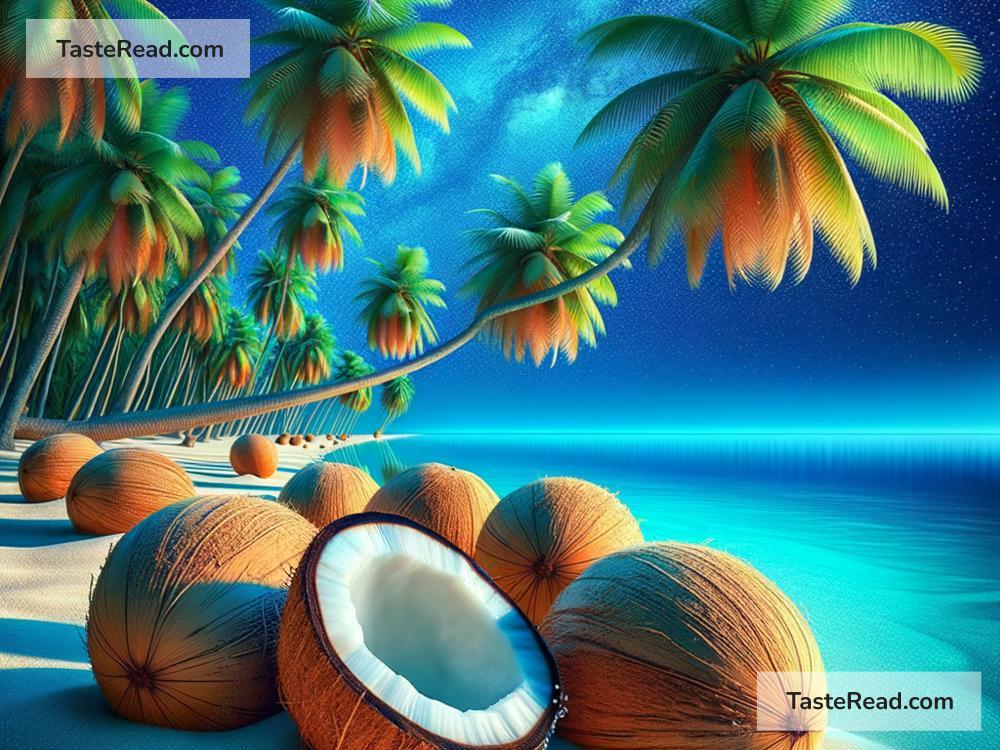How Coconuts Became Symbols of Tropical Abundance
Close your eyes and think of a tropical island. Chances are, you imagine white sandy beaches, turquoise waters, swaying palm trees, and coconuts. The coconut, a humble fruit, has become an iconic symbol of tropical paradise and abundance. But why? How did coconuts grow from being just a simple fruit to representing the beauty and warmth of tropical regions? Let’s dive into the fascinating journey of the coconut and its symbolic meaning.
The Versatile Coconut
Coconuts are truly amazing. They grow on coconut palm trees, which thrive in warm tropical climates. What makes this fruit so special is its versatility. Every part of a coconut can be used: the water inside can quench your thirst, the white meat serves as food, and the hard shell can be crafted into tools, bowls, or decorations. Even the husk can be turned into ropes or mats. No wonder people in tropical regions have relied on coconuts as a source of nourishment and survival for centuries.
The coconut palm is often called the “tree of life” because of its usefulness. In many cultures, it’s more than just a fruit; it’s a gift of nature that provides people with food, drinks, shelter, and materials for daily life. This connection to abundance is one of the reasons coconuts have become a symbol of tropical richness.
The History of Coconuts
Coconuts have an interesting story when it comes to their origins. Scientists believe coconuts originated in Southeast Asia, particularly in areas like Malaysia and Indonesia, thousands of years ago. Because of their hard, water-resistant shells, coconuts can float in seawater for weeks or even months without going bad. This ability allowed them to spread across the oceans and grow naturally on beaches in tropical regions far from their original home.
Coconuts were also carried by seafarers and traders to new lands. Coastal communities loved coconuts for their usefulness and taste. Over time, they became a common sight in areas around the Indian Ocean and Pacific Ocean. Today, you’ll find coconuts in tropical regions all over the world, from the Caribbean islands to Hawaii.
As coconuts spread across the tropics, they started gaining a reputation for being a symbol of luxury and paradise. People living in colder climates who saw coconuts or coconut palm trees associated them with sunny beaches, relaxation, and exotic getaways.
The Coconut in Culture
In tropical cultures, the coconut isn’t just a useful fruit—it’s also part of traditions, stories, and religions. For example, in Hindu rituals in India, coconuts are often used as offerings to gods. The coconut’s hard shell and delicious inside are believed to represent perseverance and purity. In Pacific Island traditions, coconuts symbolize community and sharing, as they are often exchanged during gatherings or ceremonies.
The coconut’s shape and appearance also make it stand out. It’s unique: round and hard on the outside, with sweet water and soft meat inside. This combination of toughness and reward has inspired many stories and legends about resilience and nature’s bounty.
In modern times, cultural connections have spread. Coconuts are featured in everything from drinks like piña coladas to beauty products like coconut oil. The more people have experienced coconuts, the more they’ve come to associate them with tropical cultures and their warm, welcoming spirit.
The Influence of Media and Tourism
One major reason coconuts became symbols of tropical abundance is their role in media and tourism. Think of travel brochures, cartoons, or movies that show tropical scenes. How often do you see coconuts sitting on a beach or used as props to represent island living? Coconuts are everywhere. They symbolize relaxation, fun, and escape from the busy world.
Tourism also played a part in spreading this symbolic status. As travelers from colder countries visited tropical destinations, coconuts became one of the iconic images they took home. Coconut drinks served in their shells and photos of palm trees helped create the idea of coconuts as representations of paradise. Over time, coconuts were firmly established as symbols of tropical abundance.
Why Coconuts Inspire Us
Coconuts remind us of life in harmony with nature. In tropical areas, coconuts grow without much effort—just sunlight, soil, and rain. This effortless abundance represents the tropical lifestyle, where nature provides for people abundantly. Whether it’s the sight of a coconut tree swaying in the wind or the taste of fresh coconut water, coconuts make us think of simpler, happier times.
Moreover, coconuts encourage a feeling of connection. They’ve been part of many cultures and traditions around the world, bringing people together through food, drink, and artistry. Even in global recipes and products, the coconut’s essence makes us feel closer to tropical regions and their way of life.
Conclusion
The coconut’s journey from useful fruit to global symbol is truly incredible. Its versatility, history, and cultural significance have solidified its role as a representation of tropical abundance and paradise. Coconuts remind us of nature’s beauty and generosity. Whether you’re sipping coconut water on a sunny beach or enjoying a coconut dessert at home, this iconic fruit carries the spirit of tropical warmth with it.
So next time you see a coconut, take a moment to appreciate its history, meaning, and connection to the tropical lands that inspired its status as a symbol of abundance. It’s more than just a fruit—it’s a piece of paradise in your hands.


